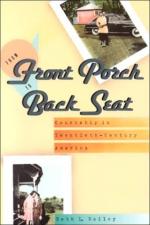|
This section contains 541 words (approx. 2 pages at 400 words per page) |

|
From Front Porch to Back Seat: Courtship in Twentieth-century America Summary & Study Guide Description
From Front Porch to Back Seat: Courtship in Twentieth-century America Summary & Study Guide includes comprehensive information and analysis to help you understand the book. This study guide contains the following sections:
This detailed literature summary also contains Topics for Discussion and a Free Quiz on From Front Porch to Back Seat: Courtship in Twentieth-century America by Beth L. Bailey.
From Front Porch to Back Seat: Courtship in Twentieth-Century America is a history of male-female 'courtship' or the system by which American males and females engaged in and initiated sexual and social intimacy prior to marriage from 1900 to 1988. Beth Bailey, a social and cultural historian at Temple University, argues that the system of American courtship has changed dramatically over the past eighty years due to economic, social, and cultural forces. At different times in American history, courtship has served many functions and symbolized various things. Courtship varied according to the appropriate degree of sexual intimacy. It has been pursued at different ages, in different places, and with varying degrees of financial commitment.
The book has six chapters, an introduction, and an epilogue, which focus primarily on courtship practices between 1920 and 1965. 'Dating' developed in the early 1920s, which replaced the 'calling' system that existed prior to it. The call system connected men and women by having 'gentlemen-callers' visit women's home by the permission of the woman's family or the woman herself. The call system involved very little if any sexual intimacy prior to marriage.
The system of dating arose in response to the development of a national youth culture due to World War I and a growing public school system. It began first as a response of lower-class women to their financial inability to engage in the call system. But the middle and upper classes started to imitate the poor, often venturing out into public as a pair and entering a private world of youth away from home. The system came to be dominated by money, which the author laments because she sees it as commodifying human relationships.
Dating became a system of intense competition to see who could date the most individuals. This high-frequency low-intimacy form of dating dominated until World War II, when men returning from war were now interested in the security of a permanent relationship. 'Going steady' became widespread and the marriage age fell substantially. 'Dating' still occurred but it was more exclusive, romantic, and involved more sexual intimacy. The 'going steady' system started to break down as the economy grew and women entered the workplace, undermining the need for security following World War II. A new form of insecurity arose about the boundaries between gender identities which caused new norms of 'proving' masculinity and femininity to arise. This system tended to put enormous pressure on women to maintain their 'womanly virtue.'
During this time, a series of experts began to decide that managing marriage through education was a good idea and marriage courses became standard fare at American colleges. The system continued to rigidify courtship rituals and gender roles. The pressure, in the author's view, eventually became too intense and broke down in the not-out-of-the-blue sexual revolution that started in the mid-1960s. The six chapters cover this surprising evolution.
The author concludes that there was no 'traditional' system of courtship. Each period of American courtship had its costs and benefits, from the call system all the way to the contemporary system that trades primarily in sex. The book is noteworthy for its thesis, along with its documentation of how American media and social scientists played a role in these changing trends.
Read more from the Study Guide
|
This section contains 541 words (approx. 2 pages at 400 words per page) |

|



